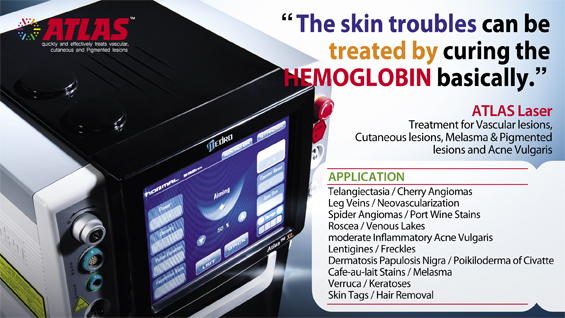▶ Previous Artlcle : #11-1. Development of Hair Removal Lasers III
2. Long Pulse Alexandrite Laser
The long pulse alexandrite laser can be effectively used in Asian patients and is the most popular hair removal laser in Korea along with the diode laser. Gentlelase and Apogee are the most representative devices. Lately, GentleMax and EliteMPX were released and could possibly offer improved results.
[Advertisement] ATLAS(Long pulse 532nm & 940nm dual wavelength) – Manufacturer: MEDRO(www.medro.net)
In 2003, Goldberg performed a 9-month follow-up of 144 Asian subjects and found that one procedure reduced 32% of hair, two reduced 44%, and three reduced 55% (Hussain M, Polnikorn N, Goldberg DJ. Laser-assisted hair removal in Asian skin: efficacy, complications, and the effect of single versus multiple treatments. Dermatol Surg 2003: 29 (3): 249~254). In 2008, Davoudi performed 4 procedures in skin type III-IV with 8-week intervals between procedures (long-pulsed alexandrite laser, 12 and 18 mm spot size, 1.5 ms pulse duration and fluences of 20 or 40J/cm2) and 18-month follow-up. He reported that 76~84% of hair was reduced (Davoudi SM, Behnia F, Gorouhi F, et al. Comparison of long-pulsed alexandrite and Nd:YAG lasers, individually and in combination, for leg hair reduction: an assessorblinded, randomized trial with 18months of follow-up. Arch Dermatol 2008: 144 (10): 1323~1327).
3. Diode Laser
LightSheer is the most representative diode laser for hair removal and uses a 800-810nm conductor. Lately, due to the high cost of conductor, diode lasers with a low wattage are being released. Doctors will need to carefully examine mechanical characteristics (spot size, fluence, and pulse duration, etc.) of the device before purchase. In general, low power and long pulse duration are set to raise the fluence. As the final outcome of a hair removal procedure takes at least two years, doctors without this knowledge may inaccurately evaluate the effect of this laser. In 2000, Lou reported that 40% of hair was reduced 20 months after one or two procedures (9mm spot size, pulse duration of 5~30ms, fluences of 15~40J/cm2) (Lou WW, Quintana AT, Geronemus RG, Grossman MC. Prospective study of hair reduction by diode laser (800 nm) with long-term follow-up. Dermatol Surg 2000: 26 (5):428~432). In 2001, Eremia performed 4 procedures (9mm spot size, pulse duration of 5~30ms, fluences of 12~40J/cm2) and found that 84% of hair was reduced after one year (Eremia S, Li C, Newman N. Laser hair removal with alexandrite versus diode laser using four treatment sessions:1-year results. Dermatol Surg 2001: 27 (11): 925~929. Discussion 929~930). The diode laser used in the above two studies was high-power and doctors using diode lasers with lower output may experience inferior efficacy.
4. Long Pulse Nd:YAG Laser
This laser may be the most effective and safest laser for African-Americans, however, very few reliable large studies show this laser’s effect on long-term hair removal in Asians or Caucasians, relative to alexandrite or high-output diode lasers (Omar A. Ibrahimi, Mathew M. Avram, C. William Hanke, Suzanne L. Kilmer, R. Rox Anderson, Laser hair removal. Dermatologic Therapy, Vol. 24, 2011, 94~107).
However, in 2001, Alster performed a non-randomized study and found that monthly procedures for three months in the face, armpit and leg resulted in 70-90% hair reduction a year later (Alster TS, Bryan H, Williams CM. Longpulsed Nd:YAG laser-assisted hair removal in pigmented skin: a clinical and histological evaluation. Arch Dermatol 2001: 137 (7): 885~889).
5. IPL
IPL is 400-1200nm polychromatic noncoherent light and is used to destroy specific chromophores with various filters. It is unlikely to bring long-term effect (Omar A. Ibrahimi, Mathew M. Avram, C. William Hanke, Suzanne L. Kilmer, R. Rox Anderson, Laser hair removal. Dermatologic Therapy, Vol. 24, 2011, 94~107) and the following two studies report IPL’s inferior efficacy compared to lasers:
1. McGill DJ, Hutchison C, McKenzie E, McSherry E, Mackay IR. A randomised, splitface comparison of facial hair removal with the alexandrite laser and intense pulsed light system. Lasers Surg Med 2007: 39 (10): 767~772.
2. Goh CL. Comparative study on a single treatment response to long pulse Nd : YAG lasers and intense pulse light therapy for hair removal on skin type IV to VI – is longer wavelengths lasers preferred over shorter wavelengths lights for assisted hair removal. J Dermatolog Treat 2003: 14(4): 243~247).
6. Combination treatment
Khoury found that alternation between alexandrite and Nd:YAG lasers failed to show added benefit (Khoury JG, Saluja R, Goldman MP. Comparative evaluation of long-pulse alexandrite and long-pulse Nd : YAG laser systems used individually and in combination for axillary hair removal. Dermatol Surg 2008: 34 (5): 665~670. Discussion 670~661). It is advisable to choose one device with proven efficacy and carefully set the treatment power level. Not to make missed hair patches is also very important.
-To be continued-
▶ Next Artlcle : #12-1. Revival of IPL and Advent of Radiofrequency and Fractional Photothermolysis





















